Durham Cathedral
The Cathedral Church of Christ, Blessed Mary the Virgin and St Cuthbert of Durham,[1][2][4] commonly known as Durham Cathedral[5][6][7] and home of the Shrine of St Cuthbert,[8] is a cathedral in the city of Durham, England. It is the seat of the Bishop of Durham, the fourth-ranked bishop in the Church of England hierarchy. The present cathedral was begun in 1093, replacing the Saxon 'White Church', and is regarded as one of the finest examples of Norman architecture in Europe.[9] In 1986 the cathedral and Durham Castle were designated a UNESCO World Heritage Site.[10]
| Durham Cathedral | |
|---|---|
| The Cathedral Church of Christ, Blessed Mary the Virgin and St Cuthbert of Durham | |
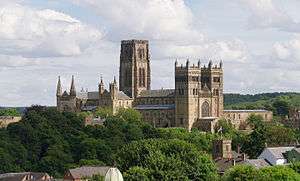 Durham Cathedral from the north-west | |
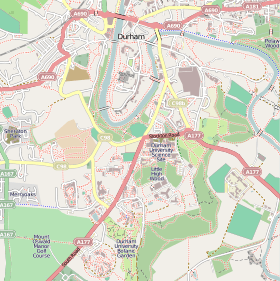 Durham Cathedral Location within Durham | |
| Location | Durham |
| Country | England |
| Denomination | Church of England |
| Tradition | Broad Church |
| Website | durhamcathedral.co.uk |
| Architecture | |
| Style | Gothic, Norman, Decorated |
| Years built | 1093–1133, additions until 1490. |
| Specifications | |
| Length | 469 feet (143 m) (interior) |
| Nave width | 81 feet (25 m) (inc aisles) |
| Nave height | 73 feet (22 m) |
| Choir height | 74 feet (23 m) |
| Number of towers | 3 |
| Tower height | 218 feet (66 m) (central tower) 144 feet (44 m) (western towers) |
| Number of spires | 0 (2 on western towers until 1658) |
| Administration | |
| Diocese | Durham (since 635 as Lindisfarne, 995 as Durham) |
| Province | York |
| Clergy | |
| Bishop(s) | Paul Butler |
| Dean | Andrew Tremlett |
| Precentor | Michael Hampel (Vice-Dean) |
| Chancellor | Charlie Allen |
| Canon(s) | Sophie Jelley (Dir. Mission) Simon Oliver (Professor) |
| Archdeacon | Ian Jagger |
| Laity | |
| Director of music | Daniel Cook (Organist and Master of the Choristers) |
| Organist(s) | Francesca Massey (Sub-Organist) |
| Chapter clerk | Amanda Anderson |
| Lay member(s) of chapter | Cathy Barnes Ivor Stolliday (Treasurer) |
| Part of | Durham Castle and Cathedral |
| Criteria | Cultural: ii, iv, vi |
| Reference | 370 |
| Inscription | 1986 (10th session) |
Durham Cathedral holds the relics of Saint Cuthbert, transported to Durham by Lindisfarne monks in the ninth century, the head of Saint Oswald of Northumbria, and the remains of the Venerable Bede. In addition, its library contains one of the most complete sets of early printed books in England, the pre-Dissolution monastic accounts, and three copies of Magna Carta.
From 1080 until 1836 the Bishop of Durham held the powers of an Earl Palatine, exercising military and civil leadership as well as religious leadership, in order to protect the English Border with Scotland. The cathedral walls formed part of Durham Castle, the chief seat of the Bishop of Durham.[11]
There are daily Church of England services at the cathedral, with the Durham Cathedral Choir singing daily except Mondays and when the choir is on holiday. It is a major tourist attraction and received 694,429 visitors in 2018.[12]
History
Anglo-Saxon
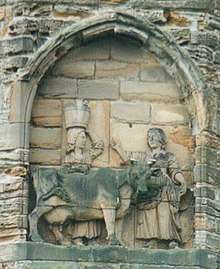
The See of Durham takes its origins from the Diocese of Lindisfarne, founded by Saint Aidan at the behest of Oswald of Northumbria in about 635, which was translated to York in 664. The see was reinstated at Lindisfarne in 678 by the Archbishop of Canterbury. Among the many saints who originated at Lindisfarne Priory, the greatest was Saint Cuthbert, Bishop of Lindisfarne from 685 until his death in 687, who is central to the development of Durham Cathedral.[13]
After repeated Viking raids, the monks fled from Lindisfarne in 875, carrying Saint Cuthbert's relics with them. The diocese of Lindisfarne remained itinerant until 882, when the monks resettled at Chester-le-Street, 60 miles south of Lindisfarne and 6 miles north of Durham. The see remained at Chester-le-Street until 995, when further Viking incursions once again caused the monks to move with their relics. According to the local legend of the Dun Cow and the Saint's hagiography, the monks followed two milk maids who were searching for a dun-coloured cow and found themselves on a peninsula formed by a loop in the River Wear. Thereupon Cuthbert's coffin became immovable, which was taken as a sign that the new shrine should be built on that spot, which became the City of Durham. A more prosaic set of reasons for the selection of the peninsula is its highly defensible position, and that a community established there would enjoy the protection of the Earl of Northumbria, with whom the bishop at this time, Aldhun, had strong family connections. Today the street leading from The Bailey past the cathedral's eastern towers up to Palace Green is named Dun Cow Lane due to the miniature dun cows which used to graze in the pastures nearby.
Initially, a very simple temporary structure was built from local timber to house the relics of Saint Cuthbert. The shrine was then transferred to a sturdier, probably still in wooden, building known as the White Church. This church was itself replaced three years later in 998 by a stone building also known as the White Church, which in 1018 was complete except for its tower. Durham soon became a site of pilgrimage, encouraged by the growing cult of Saint Cuthbert. King Canute was one of the early pilgrims, and granted many privileges and estates to the Durham monks.[14] The defensible position, flow of money from pilgrims and power embodied in the church at Durham all encouraged the formation of a town around the cathedral, which established the core of the city.
Norman
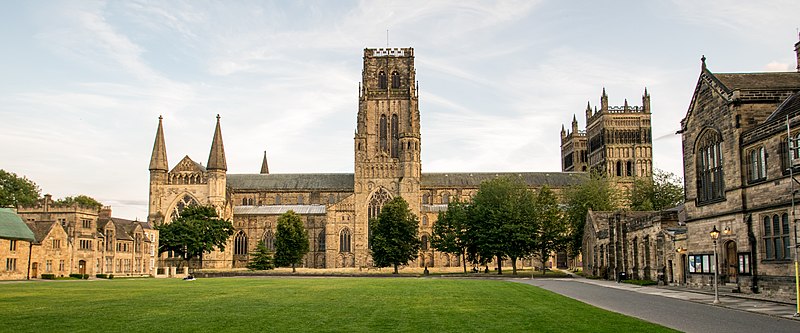
The present cathedral was designed and built under William de St-Calais (also known as William of St. Carilef) who in 1080 was appointed as the first Prince-Bishop by King William the Conqueror.[15] In 1083 he founded the Benedictine Priory of St. Cuthbert at Durham and having ejected the secular canons (and their wives and children) who had been in charge of the church and shrine of St Cuthbert there, replaced them with monks from the monasteries of Wearmouth and Jarrow. The extensive lands of the church he divided between his own bishopric and the new Priory.[16] He appointed Aldwin as the first prior.
Bishop William of St. Calais demolished the old Saxon church, and on 11 August 1093, together with Prior Turgot of Durham (Aldwin's successor), he laid the foundation stone of the great new cathedral.[17] The monks continued at their own expense to build the monastic buildings while the bishop took the responsibility for completing the building of the cathedral.[17] Stone for the new buildings was cut from the cliffs below the walls and moved up using winches.[18] The primary reason for the cathedral was to house the bodies of St. Cuthbert and the Venerable Bede.[19]
Since that time many major additions and reconstructions of parts of the building have been made, but the greater part of the structure remains the original Norman structure. Construction of the cathedral began in 1093, at the eastern end. The choir was completed by 1096. At the death of Bishop William of St. Calais on 2 January 1096, the Chapter House was ready enough to be used as his burial place. In 1104 the remains of St. Cuthbert were translated with great ceremony to the new shrine in the new cathedral. The monks continued to look after the Shrine of St Cuthbert until the Dissolution of the Monasteries.[17]
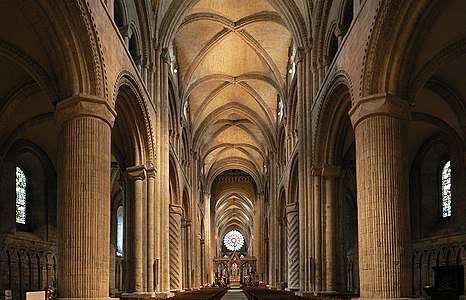
Work proceeded on the nave, the walls of which were finished by 1128, and the high vault by 1135. The chapter house was built between 1133 and 1140[20] (partially demolished in the 18th century). William of St. Carilef died in 1096 before the building was complete and passed responsibility to his successor, Ranulf Flambard, who also built Framwellgate Bridge, the earliest crossing of the River Wear from the town. Three bishops, William of St. Carilef, Ranulf Flambard and Hugh de Puiset, are all buried in the now rebuilt chapter house.
In the 1170s Hugh de Puiset, after a false start at the eastern end where subsidence and cracking prevented work from continuing, added the Galilee Chapel at the west end of the cathedral.[21] The five-aisled building occupies the position of a porch and functioned as a Lady chapel with the great west door being blocked during the Medieval period by an altar to the Virgin Mary. The door is now blocked by the tomb of Bishop Thomas Langley. The Galilee Chapel also holds the remains of the Venerable Bede. The main entrance to the cathedral is on the northern side, facing the castle.
In 1228 Richard le Poore, Bishop of Salisbury, was translated to Durham, having just rebuilt Salisbury Cathedral in the Gothic style.[21] At that moment the eastern end of Durham Cathedral was in urgent need of repair and the proposed eastern extension had failed. Le Poore employed the architect Richard Farnham to design an eastern terminal for the building in which many monks could say the Daily Office simultaneously. The resulting building was the Chapel of the Nine Altars. In 1250, the original roof of the cathedral was replaced by a vault which is still in place.[22]
The towers also date from the early 13th century, but the central tower was damaged by lightning and replaced in two stages in the 15th century, the master masons being Thomas Barton and John Bell.[20]
The Bishop of Durham was the temporal lord of the palatinate, often referred to as a Prince-bishop. The bishop competed for power with the Prior of Durham Monastery, a great landowner who held his own courts for his free tenants. An agreement dated about 1229, known as Le Convenit was entered into to regulate the relationship between the two magnates.[23]
The Shrine of Saint Cuthbert was located in the eastern apsidal end of the cathedral. The location of the inner wall of the apse is marked on the pavement and Saint Cuthbert's tomb is covered by a simple slab. However, an unknown monk wrote in 1593:
[The shrine] was estimated to be one of the most sumptuous in all England, so great were the offerings and jewells bestowed upon it, and endless the miracles that were wrought at it, even in these last days.
— Rites of Durham, [21]
Dissolution
During the Dissolution of the Monasteries Saint Cuthbert's tomb was destroyed in 1538 by order of King Henry VIII,[15] and the monastery's wealth was handed over to the king. The body of the Saint was exhumed, and according to the Rites of Durham, was discovered to be uncorrupted. It was reburied under a plain stone slab now worn smooth by the knees of pilgrims, but the ancient paving around it remains intact. Two years later, on 31 December 1540, the Benedictine monastery at Durham was dissolved, and the last Prior of Durham, Hugh Whitehead, became the first dean of the cathedral's secular chapter.[21]
17th century
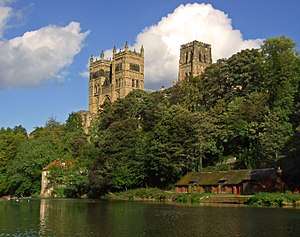
After the Battle of Dunbar in September 1650, Durham Cathedral was used by Oliver Cromwell as a makeshift prison to hold Scottish prisoners of war. It is estimated that as many as 3,000 were imprisoned of whom 1,700 died in the cathedral itself, where they were kept in inhumane conditions, largely without food, water or heat. The prisoners destroyed much of the cathedral woodwork for firewood but Prior Castell's Clock, which featured the Scottish thistle, was spared. It is reputed that the prisoners' bodies were buried in unmarked graves (see further, '21st century' below) and the survivors were shipped as slave labour to the American Colonies.
Bishop John Cosin (in office 1660–1672), previously a canon of the cathedral, set about restoring the damage and refurnishing the building with new stalls, the litany desk and the towering canopy over the font. An oak screen to carry the organ was added at this time to replace a stone screen pulled down in the 16th century. On the remains of the old refectory, Dean John Sudbury founded a library of early printed books.[21]
.jpg)
18th and 19th centuries
.jpg)
During the 18th century the Deans of Durham often held another position in the south of England and after spending the statutory time in residence, would depart southward to manage their affairs. Consequently, after Cosin's refurbishment, there was little by way of restoration or rebuilding. When work commenced again on the building, it was not always of a sympathetic nature. In 1777 the architect George Nicholson, having completed Prebends' Bridge across the Wear, persuaded the dean and chapter to let him smooth off much of the outer stonework of the cathedral, thereby considerably altering its character.[21] His successor William Morpeth demolished most of the Chapter House.[24]
In 1794 the architect James Wyatt drew up extensive plans which would have drastically transformed the building, including the demolition of the Galilee Chapel, but the Chapter changed its mind just in time to prevent this happening. Wyatt renewed the 15th-century tracery of the Rose Window, inserting plain glass to replace what had been blown out in a storm.[25]
In 1847 the architect Anthony Salvin removed Cosin's wooden organ screen, opening up the view of the east end from the nave,[26][27]
and in 1858 he restored the cloisters.[28][29]
The Victorian restoration of the cathedral's tower in 1859-60 was by the architect George Gilbert Scott, working with Edward Robert Robson (who went on to serve as Clerk of Works at the cathedral for six years).[30] In 1874 Scott was responsible for the marble choir screen and pulpit in the Crossing.[26] In 1892 Scott's pupil Charles Hodgson Fowler rebuilt the Chapter House as a memorial to Bishop Joseph Barber Lightfoot.
The great west window, depicting the Tree of Jesse, was the gift of Dean George Waddington in 1867. It is the work of Clayton and Bell, who were also responsible for the Te Deum window in the South Transept (1869), the Four Doctors window in the North Transept (1875), and the Rose Window of Christ in Majesty (c. 1876).[31]
_(33802721126).jpg)
There is also a statue of William Van Mildert, the last prince-bishop (1826–1836) and driving force behind the foundation of Durham University.
20th century
In the 1930s, under the inspiration of Dean Cyril Alington, work began on restoring the Shrine of Saint Cuthbert behind the High Altar as an appropriate focus of worship and pilgrimage, and was resumed after the Second World War. The four candlesticks and overhanging tester (c. 1950) were designed by Ninian Comper. Two large batik banners representing Saints Cuthbert and Oswald, added in 2001, are the work of Thetis Blacker.[32] Elsewhere in the building the 1930s and 1940s saw the addition of several new stained glass windows by Hugh Ray Easton. Mark Angus' Daily Bread window dates from 1984.[33] In the Galilee Chapel a wooden statue of the Annunciation by the Polish artist Josef Pyrz was added in 1992, the same year as Leonard Evetts' Stella Maris window.
In 1986, the cathedral, together with the nearby Castle, became a World Heritage Site. The UNESCO committee classified the cathedral under criteria C (ii) (iv) (vi), reporting, "Durham Cathedral is the largest and most perfect monument of 'Norman' style architecture in England".[34]
In its discussion of the significance of the cathedral, Historic England provided this summary in their 1986 report:[10]
The relics and material culture of the three saints buried at the site. The continuity of use and ownership of the site over the past 1000 years as a place of religious worship, learning and residence; The site's role as a political statement of Norman power imposed upon a subjugate nation, as one of the country's most powerful symbols of the Norman Conquest of Britain; The importance of the site's archaeological remains, which are directly related to the site's history and continuity of use over the past 1000 years; The cultural and religious traditions and historical memories associated with the relics of St Cuthbert and the Venerable Bede, and with the continuity of use and ownership of the site over the past millennium.
In 1996, the Great Western Doorway was the setting for Bill Viola's large-scale video installation The Messenger, that was commissioned by Durham Cathedral.
21st century
At the beginning of this century two of the altars in the Nine Altars Chapel at the east end of the cathedral were re-dedicated to Saint Hild of Whitby and Saint Margaret of Scotland: a striking painting of Margaret (with her son, the future king David) by Paula Rego was dedicated in 2004.[35] Nearby a plaque, first installed in 2011 and rededicated in 2017, commemorates the Scottish soldiers who died as prisoners in the cathedral after the Battle of Dunbar in 1650. The remains of some of these prisoners have now been identified in a mass grave uncoverered during building works in 2013 just outside the cathedral precinct near Palace Green.[36]
In 2004 two wooden sculptures by Fenwick Lawson, Pietà and Tomb of Christ, were placed in the Nine Altars Chapel, and in 2010 a new stained glass window of the Transfiguration by Tom Denny was dedicated in memory of Michael Ramsey, former Bishop of Durham and Archbishop of Canterbury.[37]
In 2016 former monastic buildings around the cloister, including the Monks' Dormitory and Prior's Kitchen, were re-opened to the public as Open Treasure, an extensive exhibition displaying the cathedral's history and possessions.
In November 2009 the cathedral featured in the Lumiere festival whose highlight was the "Crown of Light"[38] illumination of the North Front of the cathedral with a 15-minute presentation that told the story of Lindisfarne and the foundation of cathedral, using illustrations and text from the Lindisfarne Gospels. The Lumiere festival was repeated in 2011, 2013, 2015, and 2017.[39]
Durham Priory held many manuscripts; in the 21st century, steps were under way to digitise the books, originating from the 6th to the 16th century. The project was being undertaken in a partnership by Durham University and Durham Cathedral.[40][41]
The cathedral church and the cloister is open to visitors during certain hours each day, unless it is closed for a special event. In 2017 a new "Open Treasure" exhibition area opened featuring the 8th-century wooden coffin of Saint Cuthbert, his gold and garnet pectoral cross, a portable altar and an ivory comb.[42] This exhibition was continuing as of October 2019. In that month, a new exhibit was added, Mapping the World, featuring books, maps and drawings and from the archives, scheduled to run until 18 January 2020.[43][44]
Architecture
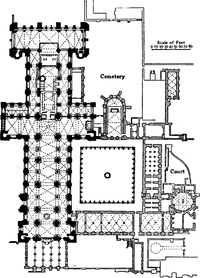
There is some evidence that the aisle of the choir had the earliest rib vaults in England, as was argued by John Bilson, English architect, at the end of the nineteenth century. Since then it has been argued that other buildings like Lessay Abbey in northwest France provided the early experimental ribs that created the high technical level shown in Durham. There is evidence in the clerestory walls of the choir that the high vault had ribs. There is controversy between John James and Malcolm Thurlby on whether these rib vaults were four-part or six-part, which remains unresolved.
The building is notable for the ribbed vault of the nave, with some of the earliest transverse pointed arches supported on relatively slender composite piers alternated with massive drum columns, and lateral abutments concealed within the triforium over the aisles. These features appear to be precursors of the Gothic architecture of Northern France, possibly due to the Norman stonemasons responsible, although the building is considered Romanesque overall. The skilled use of the pointed arch and ribbed vault made it possible to cover far more elaborate and complicated ground plans than before. Buttressing made it possible to build taller buildings and open up the intervening wall spaces to create larger windows.
The UNESCO World Heritage Site description makes this comment about the architectural style:[45]
Though some wrongly considered Durham Cathedral to be the first ‘Gothic’ monument (the relationship between it and the churches built in the Île-de-France region in the 12th century is not obvious), this building, owing to the innovative audacity of its vaulting, constitutes, as do Spire [Speyer] and Cluny, a type of experimental model which was far ahead of its time.
Another United Nations web site states that[46]
"the use of stone ‘ribs’ forming pointed arches to support the ceiling of the nave was an important achievement, and Durham Cathedral is the earliest known example" [and] The nave vault of Durham Cathedral is the most significant architectural element ... because it marks a turning point in the history of architecture. The pointed arch was successfully used as a structural element for the first time here in this building. Semi-circular arches were the type used prior to the adoption of the structural pointed arch — the limitations of which is that their height must be proportionate to their width".
Saint Cuthbert's tomb lies at the east in the Feretory and was once an elaborate monument of cream marble and gold. It remains a place of pilgrimage. The fragments of St Cuthbert's coffin are exhibited at the cathedral.[47]
Other burials
- Stephen Kemble, actor of the Kemble family
- William de St-Calais, in the chapter house
- Ranulf Flambard, also in the chapter house (where his tomb was opened in 1874)
- Geoffrey Rufus, also in the chapter house (where his grave was also excavated in the 19th century)
- William of St. Barbara, also in the chapter house (where his grave was also excavated in the 19th century)
- Nicholas Farnham
- Robert Neville – Bishop of Durham, in the South Aisle
- Walter of Kirkham, in the chapter house
- Robert Stitchill (his heart only)
- Robert of Holy Island, in the chapter house
- Antony Bek (Bishop of Durham)
- Thomas Sharp, in the chapel called the Galilee
- Thomas Mangey, in the east transept
- Richard Kellaw, in the chapter house
- Thomas Langley, his tomb blocking the Great West Door (necessitating the construction of the two later doors to north and south)
- James Pilkington, at the head of Beaumont's tomb in front of the high altar
- Alfred Robert Tucker, outside the cathedral[48]
- Cyril Alington, Dean of Durham and author
- John Robson, canon of Durham
- J. B. Lightfoot, Bishop
Other Memorials
- Bishop Joseph Butler
- Bishop Edward Maltby
- John Robert Davison QC MP
- Brigadier General Herbert Conyers Surtees
Dean and chapter
The cathedral is governed by the chapter which is chaired by the dean. Durham is a "New Foundation"[49] cathedral in which there are not specific roles to which members of the chapter are appointed, with the exception of the Dean and the Van Mildert Professor of Divinity. The other roles, sub-dean, precentor, sacrist, librarian and treasurer, are elected by the members of the chapter annually.
As of 29 January 2019:[50]
- Dean — Andrew Tremlett (since 17 July 2016 installation)
- Vice-Dean & Canon Precentor — Michael Hampel (since 17 November 2018 installation)[51]
- Canon Chancellor — Charlie Allen (since 22 September 2018 installation)[52]
- Archdeacon of Durham and Residentiary Canon — Ian Jagger (since 30 November 2006 collation & installation)
- Diocesan Director of Mission, Discipleship, and Ministry and Residentiary Canon — Sophie Jelley (since 3 May 2015 installation)[53]
- Van Mildert Professor of Divinity (Durham University) and Residentiary Canon — Simon Oliver (since 20 September 2015 installation)[54]
Music
Organ
In the 17th century Durham had an organ by Smith that was replaced in 1876 by Willis, with some pipes being reused in Durham Castle chapel. Harrison & Harrison worked on the organ from 1880, with several major additions to the stop list, and a refurbishment in 1996. The cases, designed by C. Hodgson Fowler and decorated by Clayton and Bell date from 1876 and are in the galleries of the choir.[55]
Organists
The first organist recorded at Durham was John Brimley in 1557. Notable organists have included the composer Richard Hey Lloyd and choral conductor David Hill.
The current Master of the Choristers and Organist is Daniel Cook, having succeeded James Lancelot in 2017. The Sub-Organist is Joseph Beech.
Choir
There is a regular choir of adult lay clerks, choral scholars and child choristers. The latter are educated at the Chorister School. Traditionally child choristers were all boys, but in November 2009 the cathedral admitted female choristers for the first time.[56][57] The girls and the boys serve alternately, not as a mixed choir, except at major festivals such as Easter, Advent and Christmas when the two "top lines" come together.
Meridian line
In 1829 the Dean and Chapter authorised the engraving of a meridian line upon the floor and wall of the north cloister. A circular aperture about 1 inch (2.5 cm) in the tracery of the adjoining window about 10 feet (3 m) above the level of the floor directs a beam of sunlight to fall upon the line at the precise time when the sun passes the meridian.[58] It was constructed by William Lloyd Wharton, of Dryburn in the city, and Mr Carr, then Head Master of Durham School.[59]
Film and television
Durham Cathedral has been used as a filming location in a number of cinema and television productions. Because of its distinct Romanesque architecture, the cathedral has doubled as a number of fantasy locations in larger budget film productions, but has been seen as itself in a number of television programmes.
Film
The first major appearance of the cathedral in a film was in the 1996 adaptation of a Thomas Hardy novel, Jude.[60] The film featured scenes of leading actor Christopher Eccleston working as a mason on the exterior of the cathedral,[61] and further scenes were shot inside the cathedral, and on the adjoining Prebends Bridge.
Elizabeth, 1998, starring Cate Blanchett features the cathedral doubling as The Palace of Westminster[62] and Whitehall.[63][64][65]
Durham Cathedral featured in the first two Harry Potter films (Philosopher's Stone[66] and Chamber of Secrets[67]) as Hogwarts School of Witchcraft and Wizardry.[68] The Cloisters appeared in a number of scenes as one of the school's courtyards,[69] the Chapter House as Professor McGonagall's classroom,[70] and the Triforium upper-levels as the Forbidden Corridor. The exterior architecture of the cathedral also heavily inspired the design of the Hogwarts model used in the films, and a section of the model is noticeably styled off the cathedral, with the addition of fantastical spires.[71]
The palace set design in Snow White and The Huntsman, 2012, was largely based Durham Cathedral's architecture.[72] The production team spent four days at the cathedral conducting 3D photography of the interior, and used the data collected to build the sets both physical and digital. Most noticeably, the movie's throne room features columns patterned identically to those within the cathedral.[73]
Interior views of the cathedral were featured in the 2019 Marvel superhero film Avengers: Endgame,[74] as the indoor location of Asgard.
Television
Durham Cathedral features in a number of TV programmes. Some of its many appearances include the gameshow Treasurehunt,[75] and BBC staples like Songs of Praise [76] and The Antiques Roadshow.[77]
Architectural historian Dan Cruickshank selected the cathedral as one of his four choices for the 2002 BBC television documentary Britain's Best Buildings.[78]
It also hosted a special 2009 Christmas concert from Sting as part of a BBC2 Imagine special, also featured on PBS.[79]
In 2010 the cathedral featured in Climbing Great Buildings, which saw presenter Jonathan Foyle exploring the cathedral via climbing ropes.[80]
For an episode first broadcast in 2011, the BBC railway travelogue Great British Railway Journeys with Michael Portillo visited Durham and the cathedral. Following a Bradshaw's guide, he discusses local Victorian politics highlighted in the guide, and meets with the Cathedral Choristers.[81]
Richard Wilson: On the Road, saw actor Richard Wilson visit the cathedral on this travelogue show following the Shell Guides from the 1930s.[82] The Grayson Perry documentary, All Man, culminated in the unveiling of his artwork in the cathedral.[83][84]
The fourth episode of Britain’s Great Cathedrals with Tony Robinson, broadcast on Channel Five, featured Durham Cathedral as its subject. In it, Robinson explored the architecture, the history of the Prince Bishops, and the history of pilgrimage at the cathedral.[85][86]
Following the completion of restoration on the cathedral's tower in May 2019, BBC Breakfast broadcast from the tower in as part of its reopening to the public.[87]
The cathedral features noticeably in two Catherine Cookson TV dramas, The Tide of Life [88] and The Wingless Bird.[89] In the latter of these, the cathedral and the surrounding riverbanks also feature prominently in its promotional material.[90]
It also featured on TV in a number of episodes of Inspector George Gently with both interior and exterior scenes.
In Literature
| Wikisource has original text related to this article: |
Letitia Landon's atmospheric poem, Durham Cathedral, appeared in Fisher's Drawing Room Scrap Book, 1835.
Quotations
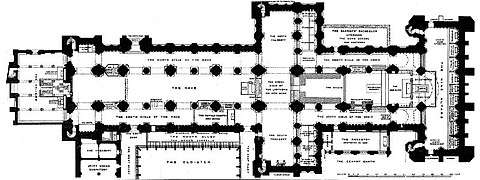

"Durham is one of the great experiences of Europe to the eyes of those who appreciate architecture, and to the minds of those who understand architecture. The group of Cathedral, Castle, and Monastery on the rock can only be compared to Avignon and Prague." — Nikolaus Pevsner, The Buildings of England
"A dream, I'm bowled over...Imagine a river valley cut into the landscape with wooded sides. The river bends, and in the bend, on the hillside, lies the old town - first the residential town, then separate from it, and higher up, the castle - and then, out on its own, in the midst of tall trees, the enormous cathedral with its twin end towers. From the bridge it is a Romantic dream, a fantasy by Schinkel. This morning in the mist it was wonderful...the first thing that has made my heart pound...the cathedral in itself, just like the Matterhorn in itself - gigantic, grey, on its own." — Pevsner in a letter to his wife, Lola, on his first English tour in 1930.[91]
"I paused upon the bridge, and admired and wondered at the beauty and glory of this scene...it was grand, venerable, and sweet, all at once; I never saw so lovely and magnificent a scene, nor, being content with this, do I care to see a better." — Nathaniel Hawthorne on Durham Cathedral, The English Notebooks
'With the cathedral at Durham we reach the incomparable masterpiece of Romanesque architecture not only in England but anywhere. The moment of entering provides for an architectural experience never to be forgotten, one of the greatest England has to offer.' — Alec Clifton-Taylor, 'English Towns' series on BBC television.
"I unhesitatingly gave Durham my vote for best cathedral on planet Earth." — Bill Bryson, Notes from a Small Island.
- "Grey towers of Durham
- Yet well I love thy mixed and massive piles
- Half church of God, half castle 'gainst the Scot
- And long to roam those venerable aisles
- With records stored of deeds long since forgot."
— Walter Scott, Harold the Dauntless, a poem of Saxons and Vikings set in County Durham.[92]
Durham Cathedral in Lego
Durham Cathedral contains a scale replica of itself made entirely out of Lego.[93] It was created as part of an award-winning fundraising campaign to support the creation of Open Treasure, and started in July 2013. It was completed just over three years later in July 2016, and is currently on display in the cathedral's Undercroft foyer between the Undercroft Restaurant and the Cathedral Shop.
The replica Cathedral is made up of 300,000 Lego bricks, standing 5 ft 6 in (1.7) tall and 12 ft 6 in (3.84m) long. It also features a modelled interior, with the nave, quire, the organ, and stained glass windows all recreated in Lego.[94][95]
Its creation was funded by donation, with a donation of £1 per Lego brick. It raised £300,000 as part of the public fundraising campaign in support of the creation of Open Treasure, the cathedral's new museum in its Claustral buildings. Visitors who donated came from 182 countries across the world. The cathedral worked with a company called Bright Bricks on the design and recruited a team of Lego volunteers who co-ordinated the build of the model and visitor donations.
The surrounding media coverage and marketing campaign garnered further support to the Lego project, especially from local businesses and organisations, and featured celebrity support such as that of Janina Ramirez, George Clarke, and Jeremy Vine. Historian and television presenter Johnathon Foyle had the honour of laying the first brick.[96]
As part of the project, a series of five Lego animated shorts were produced showcasing the history of the cathedral. North East based film maker Matt James Smith worked with the cathedral to create the shorts.[97]
See also
References
- Historic England (6 May 1952). "Cathedral Church of Christ and St. Mary the Virgin (1161023)". National Heritage List for England. Retrieved 21 December 2014.
- Durham County Council. "Cathedral Church of Christ & St Mary the Virgin: Listed Building". Archived 21 December 2014 at the Wayback Machine 2004. Accessed 21 December 2014.
- Mackenzie, Eneas & al. An Historical, Topographical, and Descriptive View of the County Palatine of Durham: Comprehending the Various Subjects of Natural, Civil, and Ecclesiastical Geography, Agriculture, Mines, Manufactures, Navigation, Trade, Commerce, Buildings, Antiquities, Curiosities, Public Institutions, Charities, Population, Customs, Biography, Local History, &c., Vol. II, p. 366. Archived 21 May 2015 at the Wayback Machine Mackenzie & Dent (Newcastle), 1834.
- Originally known as the Cathedral Church of the Blessed Mary the Virgin and St. Cuthbert the Bishop, it was renamed by Henry VIII's charter of 12 May 1541, to the "Cathedral Church of Christ and Blessed Mary the Virgin".[3] The Dedication reverted to The Cathedral Church of Christ, Blessed Mary the Virgin and St Cuthbert of Durham in a service on Sunday 4 September 2005. This was reflected in the cathedral's constitution and statutes on 16 December 2008.
- Durham Cathedral: The Shrine of St Cuthbert. "About Us". Archived 27 December 2014 at the Wayback Machine Chapter of Durham (Durham), 2014. Accessed 21 December 2014.
- A Church Near You. "Durham Cathedral, Durham". Archived 21 December 2014 at the Wayback Machine Church of England (London), 2014. Accessed 21 December 2014.
- Association of English Cathedrals "Durham Cathedral". Archived 21 December 2014 at the Wayback Machine Accessed 21 December 2014.
- Durham Cathedral: The Shrine of St Cuthbert. Official Website Archived 15 March 2009 at the Wayback Machine. Chapter of Durham (Durham), 2014. Accessed 21 December 2014.
- Pevsner, Nikolaus; Metcalfe, Priscilla (2005). The Cathedrals of England: North and East Anglia. London: The Folio Society. p. 24.
Most of what makes Durham Durham is of the short space of time between 1093 and 1133, and of that phase [...]it is one of the most perfect and also historically most interesting buildings in Europe.
- Historic England. "Durham Castle and Cathedral (1000089)". National Heritage List for England. Retrieved 29 October 2019.
- the other being Bishop Auckland
- "ALVA - Association of Leading Visitor Attractions". www.alva.org.uk. Archived from the original on 13 April 2015. Retrieved 27 July 2019.
- "Archived copy". Archived from the original on 14 May 2011. Retrieved 8 May 2011.CS1 maint: archived copy as title (link)
- http://www.englandsnortheast.co.uk/DurhamCity.html Archived 15 July 2015 at the Wayback Machine England's Great Northeast, Durham City History, Accessed July 21, 2015
- Tim Tatton-Brown and John Crook, The English Cathedral pp. 26–29.
- 'Houses of Benedictine monks: Priory of St Cuthbert, Durham (later Durham cathedral)', in Victoria County History, Durham: Volume 2, ed. William Page (London, 1907), pp. 86-103. Archived 29 October 2019 at the Wayback Machine
- Victoria County History, Durham
- "Durham of the Prince Bishops". British Heritage. Archived from the original on 29 October 2019. Retrieved 29 October 2019.
- "Archived copy". UNESCO. Archived from the original on 29 October 2019. Retrieved 29 October 2019.CS1 maint: archived copy as title (link)
- John Harvey, English Cathedrals, p. 129.
- Stranks, Durham Cathedral
- Langmead, Donald; Garnaut, Christine (6 December 2001). Encyclopedia of Architectural and Engineering Feats. ABC-CLIO. p. 99. ISBN 157607112X.
during WW II Durham castle was used as.
- Abstract from: Cynthia J. Neville, The Courts of the Prior and the Bishop of Durham in the Later Middle Ages, 2002 Archived 29 October 2019 at the Wayback Machine
- Curry, Ian (1985). Sense and Sensitivity: Durham Cathedral and its Architects (Durham Cathedral Lecture).
- Brown, David (2015). Durham Cathedral: History, Fabric and Culture. Yale University Press. pp. 198–9.
- Curry, Ian. Sense and Sensitivity.
- Brown, David (2015). Durham Cathedral: History, Fabric and Culture. Yale University Press. pp. 360–3.
- Historic England. "Cathedral cloister west range (1121389)". National Heritage List for England. Retrieved 1 October 2012.
- Historic England. "Cathedral cloister southrange (1310239)". National Heritage List for England. Retrieved 1 October 2012.
- Who Was Who, online edition, ROBSON, Edward Robert Archived 31 August 2017 at the Wayback Machine (subscription required), accessed 13 December 2008
- Brown. Durham Cathedral. pp. 204–14.
- Brown, David (2015). Durham Cathedral: History, Fabric and Culture. Yale University Press. pp. 253–63.
- Brown. Durham Cathedral. pp. 215–18.
- "Full report (PDF file)" (PDF). Archived (PDF) from the original on 15 June 2004. Retrieved 19 April 2005.
- Brown, David (2015). Durham Cathedral: History, Fabric and Culture. pp. 262–3.
- "Scottish Prisoners Project". Archived from the original on 26 September 2017. Retrieved 29 April 2017.
- Brown. Durham Cathedral. pp. 218–21.
- "Crown of Light - interview with its designer". Sky Arrts. Archived from the original on 23 May 2014. Retrieved 22 November 2013.
- "Lumiere light festival to return to Durham in 2015". ITV News. 20 January 2015. Archived from the original on 16 January 2016. Retrieved 16 January 2016.
- "Durham Priory Library Recreated". Durham Priory. 1 March 2016. Archived from the original on 29 October 2019. Retrieved 29 October 2019.
- "The Cathedral, in partnership with Durham University, is working to digitise the unique Priory Library". Durham Cathedral. 1 June 2018. Archived from the original on 29 October 2019. Retrieved 29 October 2019.
- "Cathedral displays 1,300-year-old coffin". The Times. 29 July 2017. p. 16.
- "Opening Times". Archived from the original on 29 October 2019. Retrieved 29 October 2019.
- "Durham Cathedral Open Treasure exhibition 'Mapping the World' includes world's first atlas - in pictures". Archived from the original on 29 October 2019. Retrieved 29 October 2019.
- "Durham Castle and Cathedral". UNESCO. Archived from the original on 29 October 2019. Retrieved 29 October 2019.
- "Durham World Heritage Site". UN. Archived from the original on 3 August 2019. Retrieved 29 October 2019.
- "St Cuthbert's coffin features in new display at Durham Cathedral". Fortune. 1 March 2016. Archived from the original on 19 February 2018. Retrieved 22 February 2018.
- "In Memoriam: Bishop Alfred Robert Tucker, June 19, 1914". World Digital Library. Archived from the original on 27 June 2015. Retrieved 29 April 2013.
- "Cathedrals: An Historical Note" (PDF). Church of England. Archived from the original (PDF) on 8 March 2016. Retrieved 23 November 2013.
- Durham Cathedral — Who's Who on the Cathedral Chapter Archived 24 October 2017 at the Wayback Machine (Accessed 29 January 2019)
- "Archived copy". Archived from the original on 30 January 2019. Retrieved 29 January 2019.CS1 maint: archived copy as title (link)
- "Archived copy". Archived from the original on 30 January 2019. Retrieved 29 January 2019.CS1 maint: archived copy as title (link)
- Premier — Director takes on new challenge Archived 18 January 2018 at the Wayback Machine (Accessed 18 January 2018)
- Durham Cathedral Facebook (Accessed 18 January 2018)
- Details of the organ from the National Pipe Organ Register, retrieved 1 March 2013
- "The Northern Echo: Durham Cathedral has female choristers at service". Archived from the original on 8 February 2012. Retrieved 18 November 2009.
- "Durham Cathedral — News — Here Come The girls". Archived from the original on 4 June 2011. Retrieved 18 November 2009.
- "Meridian Line". Durham County Advertiser. England. 4 July 1829. Retrieved 19 August 2017 – via British Newspaper Archive.
- Gatty, Mrs. Alfred (1900). The Book of Sun-dials. George Bell & Sons. p. 25.
- Jude (1996) - IMDb, archived from the original on 31 January 2016, retrieved 17 June 2019
- Jude (1996), retrieved 17 June 2019
- Elizabeth (1998) - IMDb, archived from the original on 10 April 2017, retrieved 17 June 2019
- "Filming Locations for Elizabeth (1997), around the UK". The Worldwide Guide to Movie Locations. Archived from the original on 7 June 2019. Retrieved 17 June 2019.
- aelarsen (20 September 2014). "Elizabeth: Why Does Elizabeth Live in a Cathedral? An Historian Goes to the Movies ~ Exploring history on the screen". Wordpress. Archived from the original on 17 June 2019. Retrieved 17 June 2019.
- Elizabeth (1998), retrieved 17 June 2019
- Harry Potter and the Sorcerer's Stone (2001) - IMDb, archived from the original on 25 February 2019, retrieved 17 June 2019
- Harry Potter and the Chamber of Secrets (2002) - IMDb, archived from the original on 20 August 2019, retrieved 17 June 2019
- "Durham Cathedral in Harry Potter: A Magical Guide to Locations, Scenes & More!". Happy to Wander. 1 April 2019. Archived from the original on 17 June 2019. Retrieved 17 June 2019.
- Harry Potter and the Sorcerer's Stone (2001), retrieved 17 June 2019
- Harry Potter and the Sorcerer's Stone (2001), retrieved 17 June 2019
- The Making of Harry Potter. "HOGWARTS CASTLE MODEL, ART DEPARTMENT". Warner Bros Studio Tour. Archived from the original on 17 May 2019. Retrieved 17 June 2019.
To make Hogwarts appear even more realistic, artists rebuilt miniature versions of courtyards from Alnwick Castle and Durham Cathedral, where scenes from Harry Potter and the Philosopher’s Stone were shot.
- Snow White and the Huntsman (2012) - IMDb, archived from the original on 4 January 2017, retrieved 17 June 2019
- IMDb (2012). "Chris Hemsworth in Snow White and the Huntsman (2012)". IMDb. Note the columns behind Hemsworth in this production image. The diamond lattice and chevron patterns on these columns are identical to those in Durham Cathedral. Archived from the original on 17 March 2017. Retrieved 17 June 2019.
- "Prepare to spot the iconic location of Durham Cathedral in Avengers: Endgame". www.durhamcathedral.co.uk. Archived from the original on 17 June 2019. Retrieved 17 June 2019.
- "Treasure Hunt" County Durham (TV Episode 1988) - IMDb, retrieved 17 June 2019
- "BBC One - Songs of Praise, Epiphany Sunday". BBC. Retrieved 17 June 2019.
- "BBC One - Antiques Roadshow, Series 37, Durham Cathedral 1". BBC. Archived from the original on 10 October 2017. Retrieved 17 June 2019.
- Cruickshank, Dan. "Choosing Britain's Best Buildings". BBC History. Archived from the original on 12 May 2007. Retrieved 3 June 2008.
- "Great Performances" Sting: A Winters Night (TV Episode 2009) - IMDb, retrieved 17 June 2019
- "BBC Two - Climbing Great Buildings, Durham Cathedral". BBC. Archived from the original on 27 July 2018. Retrieved 17 June 2019.
- "BBC Two - Great British Railway Journeys, Series 2, Durham to Grosmont". BBC. Archived from the original on 1 January 2017. Retrieved 18 June 2019.
- "Richard Wilson On The Road Episode 2". Press Centre. Archived from the original on 17 June 2019. Retrieved 17 June 2019.
- Mangan, Lucy (5 May 2016). "Grayson Perry: All Man review – making touching art out of machismo". The Guardian. ISSN 0261-3077. Archived from the original on 17 June 2019. Retrieved 17 June 2019.
- Whetstone, David (4 November 2016). "Grayson Perry banner goes on show with ancient textile relics at Durham Cathedral". nechronicle. Archived from the original on 17 June 2019. Retrieved 17 June 2019.
- "Britain's Great Cathedrals with Tony Robinson - S1 - Episode 4: Durham Cathedral". Radio Times. Archived from the original on 18 June 2019. Retrieved 18 June 2019.
- Durham Cathedral, retrieved 18 June 2019
- Breakfast, B. B. C. [@BBCBreakfast] (30 May 2019). "What a view! We stunning #Durham @SarahKLweather is LIVE from the roof @durhamcathedral for @bbcweather pic.twitter.com/OpLeR2UrFw" (Tweet). Retrieved 17 June 2019 – via Twitter.
- The Tide of Life (TV Mini-Series 1996– ) - IMDb, archived from the original on 29 October 2010, retrieved 17 June 2019
- The Wingless Bird (TV Mini-Series 1997– ) - IMDb, retrieved 17 June 2019
- The Wingless Bird (1997-), retrieved 17 June 2019
- Harries 2012, pp. 13-14.
- The verse is inscribed on a plaque on Prebends Bridge, which still affords the excellent view of the cathedral that inspired it, sometimes known as Scott's View (Pocock, D. C. D. (1982). "Scott's View". Transactions of the Institute of British Geographers. 7 (3): 354–364. doi:10.2307/621996. JSTOR 621996. and Walter Scott. "Harold the Dauntless". Archived from the original on 4 October 2006. Retrieved 7 November 2006.)
- "Durham Cathedral in LEGO". www.durhamcathedral.co.uk. Archived from the original on 16 May 2019. Retrieved 3 July 2019.
- "Final brick added to Lego cathedral". 25 July 2016. Archived from the original on 3 July 2019. Retrieved 3 July 2019.
- "BBC Newcastle - Radio for the North East". www.facebook.com. Retrieved 3 July 2019.
- "SOFII · Durham Cathedral in LEGO: innovative buy-a-brick fundraising". sofii.org. Archived from the original on 5 April 2018. Retrieved 3 July 2019.
- "Durham Cathedral". www.durhamcathedral.co.uk. Archived from the original on 3 July 2019. Retrieved 3 July 2019.
Bibliography
- Clifton-Taylor, Alec (1967) The Cathedrals of England. London: Thames and Hudson
- Dodds, Glen Lyndon (1996) Historic Sites of County Durham Albion Press
- Harvey, John (1963) English Cathedrals. London: Batsford
- Moorhouse, Geoffrey (2008) The Last Office: 1539 and the dissolution of a monastery. London: Weidenfeld & Nicolson
- Stranks, C. J. The Pictorial History of Durham Cathedral. London: Pitkin Pictorials
- Tatton-Brown, Tim (2002) The English Cathedral; text by Timothy Tatton-Brown; photography by John Crook. London: New Holland ISBN 1-84330-120-2
External links
| Wikimedia Commons has media related to Durham Cathedral. |
- Durham Cathedral website
- The Friends of Durham Cathedral
- Gallery of photos
- A Tour of Durham Cathedral & Castle
- Webcam views: zoomed, wide angle
- Voted "Britain's Favourite Building" in BBC Radio 4 poll, 2001
- A history of Durham Cathedral
- A history of Durham Cathedral choristers and choir school
- Adrian Fletcher's Paradoxplace — Durham Cathedral Pages — Photos
- Place Evocation: The Galilee Chapel
- Local History Publications from County Durham Books
- Bell's Cathedrals: The Cathedral Church of Durham — from Project Gutenberg
- Durham Cathedral — Tourist Guide to Durham Cathedral
